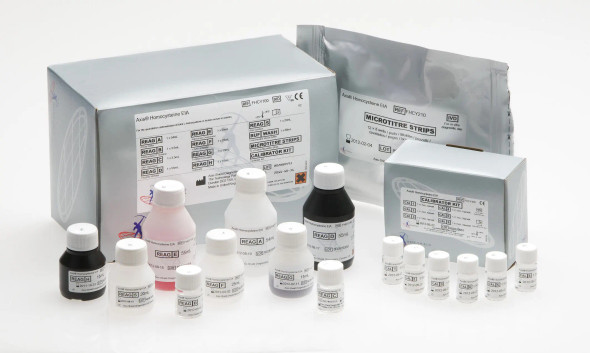Description
Intended Use
The Axis-Shield Heparin Binding Protein (HBP) assay is an enzyme immunoassay (EIA) for the quantitative determination of Heparin Binding Protein in human plasma.
Part Number: FMHBP100IUO
Method: ELISA
Description: 96-well microtire plate, liquid reagents, 6 calibrators, 3 controls
Heparin Binding Protein EIA Kit IFU
Assay Principle
The microtitre break-apart wells are coated with a monoclonal antibody to Heparin Binding Protein (HBP). During the first incubation, HBP in the sample specifically binds to the antibody-coated surface. The wells are then washed to remove unbound components. In the second incubation the Conjugate binds to any captured HBP. After further washing the bound HBP is detected by incubation with the Substrate. Addition of the Stop Solution terminates the reaction, resulting in a coloured end-product. The concentration of HBP in ng/mL is directly related to the colour generated and can be estimated by interpolation from a dose-response curve based on Calibrators.
INTENDED USE
The Axis-Shield Heparin Binding Protein (HBP) test is an immunoturbidimetric assay for the quantitative determination of Heparin Binding Protein in human plasma. The Axis-Shield Heparin Binding Protein assay is intended for use in conjunction with other laboratory findings and clinical assessments as an aid in the assessment for the presence of organ dysfunction, or risk of progression to organ dysfunction within 72 hours, in patients presenting to the Emergency Department (ED) with suspected infection.
SUMMARY
Heparin Binding Protein (HBP), also known as Cationic Antimicrobial Protein of 37kDa (CAP37) and azurocidin, is a 37kDa glycoprotein synthesised in neutrophils.1 Structurally HBP belongs to the serine protease superfamily and although it has 45% sequence identity with human neutrophil elastase, it is inactive as a protease. Although initially investigated for its antimicrobial activity, HBP has since been implicated in a number of inflammatory processes. HBP is released from the secretory vesicles of activated neutrophils on contact with the endothelium.
Once released, it induces a calcium-dependent rearrangement of the endothelial cell cytoskeleton, resulting in cell contraction and increased permeability of the endothelium. It is also internalised by the endothelial cells to protect them from apoptosis. HBP is also released from the secretory vesicles when M-protein/fibrinogen complexes, which are formed when M-proteins are released from bacterial cell surfaces, interact with ί2-integrins on the neutrophil cell surface.
At the site of infection, HBP is also secreted from the azurophil granules during phagocytosis, where it exhibits antimicrobial activity and is responsible for the recruitment and activation of monocytes and other inflammatory mediators. It is also internalised by monocytes to prolong survival and enhance cytokine production.2 HBP therefore directly contributes to the maintenance and progression of inflammation and it has been proposed that measurement of HBP could be useful in identifying patients at risk of developing sepsis with circulatory failure.
A publication in 2015 demonstrated that in febrile patients presenting to the Emergency Department (ED), HBP is an early indicator of infection-related organ dysfunction, and a strong predictor of disease progrssion to severe sepsis within 72 hours.3 In this prospective study, 806 febrile adult patients with suspected infection were enrolled, of those, 487 were confirmed as having an infection but no organ dysfunction at presentation.
In this 487 cohort, 141 progressed to develop organ dysfunction within 72 hours and in this sub-group HBP showed a sensitivity for prediction of organ dysfunction of 78.0%, a specificity of 76.3%, a positive predictive value (PPV) of 57.3% and a negative predictive value (NPV) of 89.5% which exceeded those values obtained for all other markers tested (Procalcitionin, White Cell Count, C-reactive Protein, Lactate). Receiveroperating characteristic (ROC) curves also demonstrated that HBP was the best predictor of infection-related organ dysfunction (severe sepsis), with an area under the curve (AUC) value of 0.80 (Confidence Interval (CI) 95% 0.76-0.85).
PRINCIPLE
The determination of HBP is based on a turbidimetric reaction which occurs between circulating Heparin Binding Protein and avian HBP monospecific polyclonal antibodies bound to chloromethyl microparticles at optimal pH conditions in the presence of polyethylene glycol polymer (PEG). The magnitude of the change is proportional to the quantity of HBP in the test sample.
EQUIPMENT AND MATERIALS REQUIRED BUT NOT PROVIDED
- Clinical Chemistry system capable of measuring up to 600nm with 37°C incubation. Refer to the specific Axis-Shield Clinical Chemistry HBP Application Guide.
- Axis-Shield Clinical Chemistry HBP Control Kit, Product Code FHHBP200
- Axis-Shield Clinical Chemistry HBP Calibrator Kit, Product Code FHHBP300
WARNINGS AND PRECAUTIONS
- For in vitro diagnostic use.
- Disposal of all waste material must be in accordance with local guidelines.
- Reagents contain sodium azide which can react with lead and copper plumbing to form highly explosive metal azides. On disposal, drain with large quantities of water to prevent azide build-up.
- Material safety data sheets (MSDS/SDS) are available upon request from Axis-Shield.
- Caution: Federal law restricts this device to sale by or on the order of a physician.
1 Review
-
best price
The prices are low as compared to other known companies, therefore it is highly recommended!






